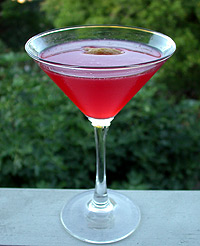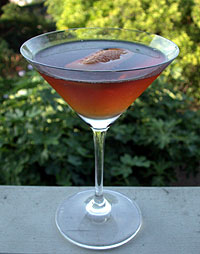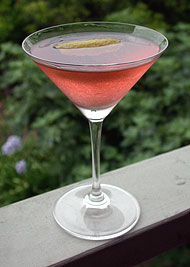My new Polish love
… is named Żubrówka.
Or “bison grass vodka”, which is perhaps a bit easier to pronounce than “zhu-BROOV-ka”. I’d been meaning to try this stuff for a while, since our friends Gregg and Mike had brought us some back from Paris. It’s the classic traditional Polish vodka, infused with native bison grass, which gives it an extremely distinctive flavor and straw-green color. Dr. Cocktail has been singing the praises of it for ages, while telling us the American brands have been artificially flavored for a while. Apparently bison grass contains coumarin, a substance with anticoagulant properties that’s also responsible for much of its flavor.
Waiting for an occasion, I suppose, we never cracked open the bottle of Żubrówka that’s been in our freezer since the boys brought it from Paris, but opportunity presented itself for a taste last night. We had dinner at Warszawa, the excellent Polish restaurant in Santa Monica, before heading to McCabe’s to see the Savoy Family Band play. It had been years since I’d been, and it was even better than I remember — bacon wrapped plums, crispy potato pancakes, grilled kielbasa sausages, pierogis of every description, beef stroganoff, thick pea soup with smoked ham and marjoram, smoked fish salad with dill … and Żubrówka! There it was, listed on the spirits menu, and what better time to try it than before a Polish meal. It arrived in a little vodka glass, ice cold right from the freezer.
I know a true Pole would scoff at me, but instead of knocking the whole thing back, I took a healthy sip first, as I wanted to savor it and get the entirety of the aroma and flavor.
Oh, my.
I instantly fell in love with this stuff. Spicy, yet almost sweet but not syrupy like a liqueur; paradoxically, it was dry yet reminded me of candy — traces of caramel and nougat and vanilla. It also tasted like green herbs, but not medicinal. I tasted flowers, and lemon, and even coconut (!), and so many things going on in there. This stuff’s dangerous. I immediately wanted more.
I’ve never read Somerset Maugham’s The Razor’s Edge, but in it one character describes the flavor of Żubrówka as smelling of “freshly mown hay and spring flowers, of thyme and lavender, and it’s soft on the palate and so comfortable, it’s like listening to music by moonlight.” I can dig it.
After enjoying our Polish meal and two-plus hours of the finest Cajun music to be heard, the very first thing we did when we got home was to crack open our bottle of authentic Polish Żubrówka. The difference between the domestic Polish and European version and the type produced for export to America is that the most authentic Żubrówka has a long blade of bison grass in the bottle, and the American version doesn’t due to USDA regulations. Apparently there’s also some artificial flavoring involved as well, although I’m not certain about that now (at least one website claims that true bison grass vodka is now legal in all 50 states). The French bottling, which we had, looks like this.
It was goooooood. It was … well, it was like the stuff we had at the restaurant, only a bit more complex, certainly subtler. It was great. However, once we run out of this stuff (and it won’t be long), I think that for the time being I’ll still be happy with the American-export version.
They say that if you travel to Poland and start drinking with the locals, don’t ever try to outdrink them (unless you’re Russian, and then only maybe). I’d better be very careful. If I’m in Warszawa or Cracow, drinking with locals, and they bring this stuff out, I’m a dead man … ’cause it’s so good I would have no incentive to stop unless I become unconscious.
Na zdrowie!
From what I understand, most if not all Poles would consider the consumption of Żubrówka in a cocktail as being a crime, an offence against decency, utter blasphemy. It’s to be consumed ice-cold, alone and quickly. However, my research seems to have uncovered an exception …
This drink, which translates from Polish as “apple tart” and is also sometimes called “Tatanka”, appears to be the one exception to the prohibition against mixing Żubrówka with anything else, and seems to be looked upon fondly. You won’t believe how tasty this is.
Szarłotka
(pronounced “shar-WOT-ka”, I think)1 ounce Żubrówka (Polish bison grass vodka).
3-4 ounces apple juice.
Lemon wedge.In a heavy rocks glass, build over ice and stir.
Garnish with the lemon wedge.
Contrary to what seems to be Polish popular opinion, I think that Żubrówka would make an excellent cocktail ingredient. Only two exist in CocktailDB, and I’ve already got some ideas.









